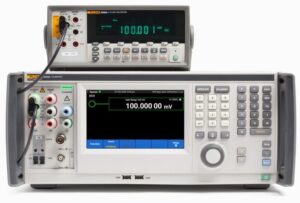The 5560A from Fluke Calibration lets you calibrate DMMs to 6½. Other models handle fewer digits.

Calibration labs, whether internal to a company or a third-party lab, constantly face pressure to decrease turnaround times while at the same time calibrating to ever-tighter tolerances. The 5560A from Fluke Calibration boosts performance, letting a single instrument calibrate more test instruments. The 5560A comes from a long line of multifunction calibrators. Go into just about any calibration lab and you’ll find a fluke calibrator.
Fluke’s most recent multifunction calibrator line includes two other variants: the 5550A (5½-digit DMMs) and 5540A (½-digit DMMs). Fluke distinguishes the 5560A based on its 4:1 test uncertainty ratio (TUR), which makes it suitable for calibrating 6½-digit multimeters (see photo). If your primary DMM workload revolves lower-resolution meters, then the 5550A is a better match. Finally, the 5540A serves mobile calibration facilities and handles most handheld DMMs.
All three calibrators let you calibrate meters for:
- AC and DC voltage and current (1020 V, 30.2 A) with higher current using an amplifier
- Resistance (0 Ω to 1200 MΩ)
- Frequency ().01 Hz to 2 MHz)
- Capacitance (200 pF to 120 mf
- Indusctance (12 µH to 12 H)
- Thermocouple output (B,C,E,J,K,L,N,R,S,U, BP and XK
10 µV/°C) - Resistance-temperature detector (RTD) output (Pt100 385, Pt100 395, Pt100 3916, Pt200 385, Pt500 385, Pt1000 385, Ni120, Cu10)
- Sine wave, triangle wave and square wave
.
Because calibration can be subject to human error or inconsistent procedures, all calibrations in the family can operate under software control through Fluke METCAL software, a third-party calibration program, or in-house-developed calibration software. Operating a calibrator under software control provides consistency, shortens test time, and automated test-data storage. All models allow remote control over RS-232, Ethernet, USB, and GPIB buses.
The 5560A adds new features such as:
- 7 in. (17.8 mm) screen with a graphical interface with color-coded fields;
- 30 A Class D transconductance amplifier;
- New output block design;
- 1000 V direct amplifier;
- Improved thermocouple input/output;
- mechanical/thermal design;
- Redesigned terminal mapping matches the calibrators’ terminal to those of populat DMMs, a simple change the reduces lead changes.
An optional Autocal DMM lead set adapter plugs directly into the calibrator’s output terminals and minimizes, which can, in some cases eliminates lead changes.

